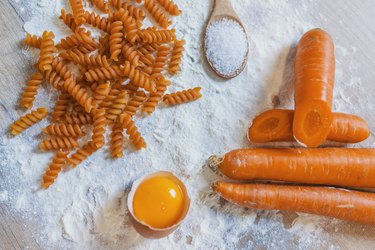
There's nothing quite like orange food coloring to set off your fall-themed baked goods or to decorate a white-frosted carrot cake. However, health concerns over artificial food dyes may tempt you to abandon these colorful concoctions. Instead, turn to either a trusted and safe food-coloring brand, or indulge your creative side by making your own homemade food coloring.
Creating Single-Ingredient Orange Food Coloring
Video of the Day
Carrot juice is sweet enough to color desserts orange without undermining the flavor. Use fresh carrots and your own juicer or buy carrot juice in the natural foods section of your supermarket. If your recipe can stand a slightly thicker liquid, experiment with using pureed and strained cooked carrots.
Video of the Day
When you're making Easter eggs, toss the outer skin of an onion peel into the water with the boiling eggs to create an intriguing deep-orange shade that can stand on its own or be a base color for tie-dyed Easter eggs. Paprika is a somewhat more limiting homemade food coloring for orange because heating will bring out its spicy flavor.
However, when you're seeking an orange shade for your chilled soup, sauce or dip, stir unheated paprika into your food item a little at a time until you have the color you desire.
Annatto seeds are another traditional source for orange homemade food coloring. The final color can vary from orange-yellow to orange-red depending on the seed batch and how long you sautee them in oil. The seeds are essentially flavorless, making the strained, cooled oil an ideal substitute for plain oil in baked goods. Look for the dried seeds in the spice aisle.
Getting Artsy With Blended Batches
Many single-ingredient orange food dyes may be a bit too savory or spicy for certain recipes. Blending fruit-based red and yellow natural food dyes may work better in those cases. Pureed and strained raspberries create a red DIY food coloring. The same treatment on mangos results in yellow.
Blend red raspberry homemade food coloring into the yellow mango coloring bit by bit until you create the orange color you need. This homemade food coloring will be sweet enough to use in baked desserts, candy and other goodies.
Bumping Up the Intensity
When you're working with natural food dyes, you may find that the color isn't as saturated as with artificial coloring. Concentrating your homemade food coloring will pump up the volume. With liquid or pulpy natural orange food coloring sources, taking as much liquid out of the dye as possible will make the resulting color brighter.
If you've created a juice or puree from carrots, for example, simmer it until it reaches the hue and consistency you need. The same holds true for red and yellow fruit purees you plan to make. Concentrates are useful if you are going to be mixing your natural dyes into white frosting, which mutes the color.
Following a recipe that calls for blending colors? If the safe food-coloring brand or natural food dyes you're using are less intense than artificial dyes, increase the amount of each color you use to create the shade of orange you want. At the same time, try to keep the overall proportions the same.
Using a Safe Food-Coloring Brand
When you're just whipping up a fast batch of Halloween cupcakes or frosted carrot cake, there's nothing quite like a tube of instant food coloring to make life easier. If you're concerned about finding a safe food-coloring brand, look for one labeled as containing natural food dyes.
It's rare to find orange included in a typical package of food coloring. Orange is created by blending red and yellow together to create the orange hue you prefer. For example, the most vivid, pumpkin-colored orange comes from about 65 drops of red and 165 drops of yellow.
- Bucknell University, Lea Wittie: Food Coloring Agents
- One Green Planet: How to Use All-Natural Plant-Based Food Colorings to Add a Pop of Color to Your Foods
- Artificial Appetite: How to Make Natural Food Coloring
- Cleveland Clinic: 9 Easy, Natural Ways to Color Your Food
- Food52: How to Make All-Natural Food Dyes From Ingredients in Your Kitchen
- Food Network: Frost by Numbers: How to Make Frosting Colors